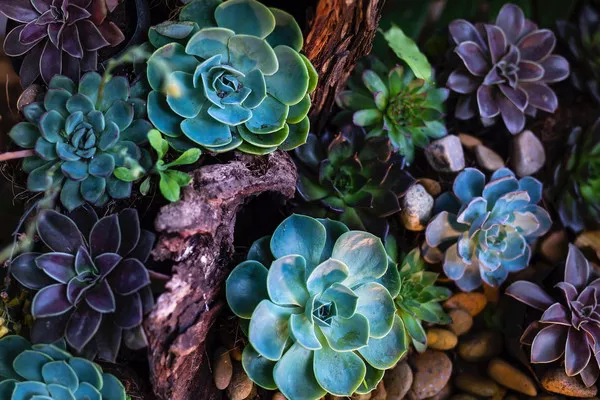The growth rate of succulents is primarily governed by environmental factors such as light, temperature, water, soil, and nutrients. Additionally, the species and genetic predisposition of the succulent play a significant role in determining its growth rate. By optimizing these variables and providing the ideal conditions, gardeners can encourage accelerated growth and robust vitality in their succulent specimens.
Optimizing Light Exposure: Maximizing Photosynthesis
Light serves as the primary source of energy for plants, driving the process of photosynthesis, wherein they convert light into chemical energy to fuel growth. Succulents, originating from regions with ample sunlight, thrive in bright, indirect light conditions. To promote faster growth, position succulents in locations where they receive at least six hours of sunlight per day.
For indoor succulents, placing them near south or west-facing windows ensures they receive optimal sunlight exposure. Supplemental lighting, such as grow lights, can be utilized to augment natural light, particularly in regions with limited daylight hours or during the winter months. However, it’s essential to strike a balance, as excessive light can lead to sunburn and damage the delicate foliage of succulents.
Regularly rotating potted succulents ensures uniform light distribution, preventing them from leaning towards a single light source. Furthermore, monitoring the intensity and duration of light exposure helps fine-tune the growing environment, fostering healthy and accelerated growth.
Temperature Regulation: Creating Optimal Conditions
Temperature plays a pivotal role in dictating the metabolic processes and growth rates of succulents. While succulents exhibit adaptability to a wide range of temperatures, they thrive in moderate to warm climates, typically between 70°F to 85°F (21°C to 29°C) during the day and 50°F to 55°F (10°C to 13°C) at night.
Maintaining consistent temperatures within this range fosters optimal growth conditions for succulents. Avoid exposing them to sudden temperature fluctuations or extremes, as these can stress the plants and impede growth. In colder regions, protecting outdoor succulents from frost and providing insulation during winter months ensures their well-being and promotes faster growth come springtime.
For indoor succulents, avoiding placement near drafts or heating vents is crucial, as these can lead to temperature fluctuations. Additionally, using thermostats or temperature-regulating devices helps create a stable environment conducive to accelerated growth.
Strategic Watering Practices: Balancing Moisture Levels
While succulents are renowned for their drought tolerance, adequate watering is essential to facilitate growth and prevent dehydration. However, overwatering is a common pitfall among succulent enthusiasts and can hinder rather than promote growth. Implementing a strategic watering regimen is key to optimizing growth rates.
Allow the soil to dry out completely between waterings, mimicking the natural drought conditions in which succulents thrive. This prevents the risk of root rot and fungal diseases caused by waterlogged soil. When watering, ensure thorough saturation, allowing excess water to drain freely from the pot’s drainage holes.
During the growing season, typically spring and summer, increase the frequency of watering to support active growth. Conversely, reduce watering during dormancy periods in fall and winter to prevent water accumulation and promote healthy root development.
Implementing a bottom-watering technique, wherein the pot is submerged in water and allowed to absorb moisture through the drainage holes, ensures efficient hydration without saturating the soil excessively. Additionally, using well-draining soil mixes specifically formulated for succulents facilitates proper water distribution and root aeration, fostering accelerated growth.
Nutrient Supplementation: Enhancing Growth Potential
In addition to water and sunlight, succulents require essential nutrients to fuel growth and maintain vitality. While they are relatively low-maintenance in terms of fertilization, providing supplemental nutrients can bolster growth rates and enhance overall health.
Opt for a balanced, water-soluble fertilizer formulated specifically for succulents, containing equal parts nitrogen, phosphorus, and potassium (NPK). Begin fertilizing in early spring, when succulents enter their active growth phase, and continue monthly throughout the growing season.
Avoid over-fertilizing, as excess nutrients can lead to salt buildup in the soil, causing root damage and inhibiting growth. Dilute the fertilizer to half or quarter strength to prevent nutrient imbalances and minimize the risk of fertilizer burn.
Alternatively, incorporating organic matter such as compost or worm castings into the soil enriches its nutrient content and promotes long-term soil health. Top-dressing succulents with a thin layer of compost or organic mulch provides a slow-release nutrient source, supporting sustained growth and vitality.
Pruning and Propagation: Stimulating Growth and Expansion
Pruning is an effective technique for stimulating growth and shaping succulents, encouraging branching and denser foliage. Remove dead or damaged leaves regularly to maintain plant hygiene and prevent the spread of disease. Additionally, trimming leggy or elongated stems promotes compact growth and enhances the aesthetic appeal of succulents.
Propagation offers an excellent opportunity to multiply succulent collections and expedite growth by leveraging existing plant material. Leaf and stem cuttings can be rooted in well-draining soil or water, initiating new growth and establishing healthy root systems. Furthermore, division allows for the separation of offsets or pups from mature plants, enabling them to develop independently and accelerate their growth trajectory.
Provide optimal conditions for newly propagated succulents, including adequate light, warmth, and moisture, to facilitate root establishment and encourage vigorous growth. With proper care and attention, propagated succulents can rapidly mature into thriving specimens, enriching your succulent garden with diversity and vitality.
Conclusion
From optimizing light exposure and temperature regulation to practicing strategic watering and nutrient supplementation, every aspect of succulent care plays a crucial role in fostering accelerated growth. Pruning and propagation techniques further stimulate growth and expansion, allowing enthusiasts to curate diverse and dynamic succulent collections. With patience, dedication, and a willingness to experiment, anyone can unlock the secrets to helping succulents grow faster, transforming humble cuttings into verdant masterpieces that adorn homes, gardens, and hearts alike. Embrace the journey of succulent cultivation, and revel in the beauty of nature’s resilience and abundance.


